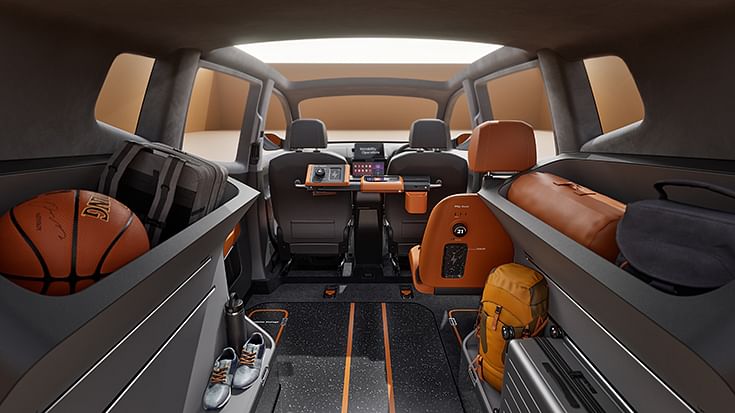Ex-Jaguar design chief creates wheelchair-accessible EV
Callum eVita concept, designed with Motability, is based on Stellantis's mid-sized electric MPV platform and has an integrated ramp, two charging ports and a rear infotainment bar.
Ex-Jaguar design chief Ian Callum has partnered with Motability to create an electric car designed specifically around wheelchair users, with unique features to make the car “more desirable” for customers than the converted vans currently on offer.
The eVita concept, created by Callum's eponymous design agency and based on Stellantis's mid-sized electric MPV platform, shows "what is possible when inclusive design and engineering are at the fore" by rethinking the conventional packaging of an EV to offer maximum interior space in as small a footprint as possible.
Measuring 4520mm long and 1908mm wide, it takes up about as much road as a Hyundai Tucson but is substantially taller at 1800mm, which, with a unique slimline battery packaged just behind the front seats rather than across the floorplan, allows a much higher ceiling than is allowed in conventional EVs of this size.
This extra space and completely flat floor mean wheelchair users can move around more easily and sit at the same height as those in the front seats, making it a more inclusive experience for vehicle occupants, Ian Callum told Autocar UK.
 Completely flat floor enables wheelchair users to move around more easily
Completely flat floor enables wheelchair users to move around more easily
The low, 180mm ride height will also reduce the risk of car sickness felt by those in the back from being seated too high – an issue that can affect current wheelchair-accessible vehicles (WAVs).
Other unique design elements include a rear-mounted ‘utility bar’ that gives those in the back access to infotainment, climate controls and more, and two charging ports, with one mounted low enough to be accessed by wheelchair users.

There are also puddle lamps that project the shape of the wheelchair ramp onto the ground, to avoid other motorists parking too close and preventing the split tailgate – which hides a built-in ramp – from opening.
A key selling point is the eVita’s design, said Callum design boss Aleck Jones: “We did a lot of research with wheelchair users, and a lot of feedback we got was that people who use the [more traditional] converted vehicles feel they stand out a bit.
“So we were really conscious that the overall aesthetic of this was something that not only a wheelchair user would look at and go ‘wow, that’s my car’ or ‘I want that thing!’.
“That’s not a vain styling exercise. This is something these owners are crying out for. They don’t want to stand out for any reason other than their car looks great.”
Ian Callum added: “It was important that this vehicle had an exotic feel about it, rather than just a decent-looking van, because, let’s face it, the vans out there are not the prettiest things in the world.”
Asked why his company took on such a project, Callum said: “The opportunity to do something which involved some serious problem-solving really appealed to us. It certainly appealed to me.
“There’s no dispute whether it was right or wrong for us. It was a great opportunity for us to say to the world that we can approach these things seriously and resolve them. We’re not just about sports cars.”
The eVita isn't immediately destined for production but rather serves as a call to action for the industry to better consider the needs of disabled users in the transition to EVs.
Motability CEO Andrew Miller said: "Collaboration is key to making the EV transition a success for wheelchair users. We need our partners, manufacturers and policy makers to believe in better and to work alongside us to take action. [The] eVita shows what can be done."
Callum also sees this project as a testbed for something that could be adapted for other uses, thanks to that unique – and “still being worked on” – battery pack design allowing extra space in the back.
Ian Callum said: “The nice thing about it is, now we’ve designed this, if we wanted it to be a vehicle that might not just be a wheelchair user’s vehicle, we could create something that maybe even appealed to uses such as pushbikes or motorbikes or camping or something like that.
“We certainly don’t want to give people the notion that it only has one practical use. We really believe if we design it properly, we will attract people who use it for other things. Because we’ve resolved the issue of the battery being in the wrong place, therefore we’ve opened up the back for a lot more activity.”
If anything did make production, it would require a bespoke platform that would allow battery packs to be fitted “not just to one specific area”, Ian Callum said, so that range wouldn't be impacted.
RELATED ARTICLES
Skoda begins sale of made-in-India CKD Kushaq in Vietnam
Before production started, pre-series Kushaq vehicles covered over 330,000 kilometres on a variety of Vietnamese roads a...
Six Japanese companies join forces to expand use of recycled materials in new vehicles
Denso, Toray Industries, Nomura Research Institute, Honda Motor, Matec Inc and Rever Corporation have set up the BlueReb...
BYD selects Voestalpine as steel supplier for its Hungarian plant
The announcement of the Austrian steelmaker as a supplier demonstrates BYD’s strategic plan to source from high-quality,...





 21 Mar 2024
21 Mar 2024
 5827 Views
5827 Views






















 Autocar Professional Bureau
Autocar Professional Bureau




